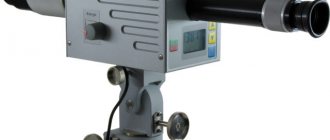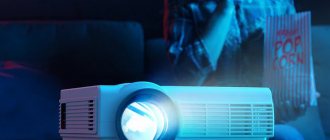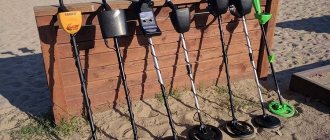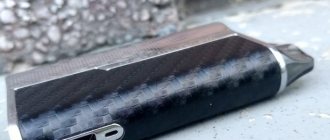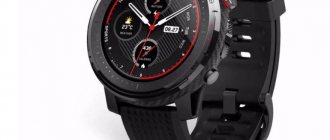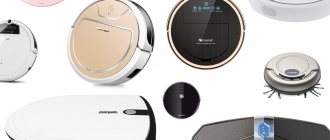Pyrometers are used for non-contact measurement of the temperature of bodies and media in industry, construction, everyday life, cooking and medicine. The characteristics of the device depend on the scope of application. For example, medicine requires a small range of measured temperatures, but high accuracy; in construction, graphical display of measurements is simply necessary, and in cooking, a probe is desirable.
What to look for when buying a pyrometer
Choosing a device that will have the best price-quality ratio and cope with all the tasks is easier if you know what to look for when purchasing.
Main types of devices
All pyrometers work by analyzing infrared radiation emanating from the object of study. But depending on the design features, the method of reading or issuing information, devices come in several types:
- Devices with a laser sight determine the temperature not of a wide spot of the surface, but of a specific point. The measurement itself occurs in the same way as with other devices; the laser here simply works as a mark. Most medical and household pyrometers have such a sight.
- Stationary devices are used in industry and production. They have good characteristics, but are large in size.
- Mobile devices are those that can be purchased at hardware stores or hardware stores. They are compact and lightweight, designed for a wide range of tasks and can have the same characteristics as stationary devices.
Depending on the way information is displayed to the user, pyrometers can be text-digital or graphic. The first display specific data: the measured temperature and service information are written in numbers. Graphic pyrometers are used when it is important to obtain not data on a specific point or area, but an overall picture, as on a thermal imager.
Characteristics of pyrometers
The optical resolution of a pyrometer is its key characteristic, which determines the accuracy of measurements at a certain distance, and, ultimately, the cost of the device. This is the ratio of the optimal distance to the measurement object and the diameter of the measurement spot. The larger it is, the more expensive the equipment costs. More advanced models have the ability to take point measurements inside the spot.
The emission coefficient is an internal correction of the device for the quality of the surface whose temperature it will measure. Most household pyrometers have an emission factor of 0.95. Such a device “sees” objects made of matte materials well: plastic, painted metal, brick, as well as the human body. If you need a device that can determine the temperature of different media and materials, it is better to choose a pyrometer with an adjustable emission coefficient.
The range of measured temperatures is on average from -50 to 500 degrees. This is enough for household and construction needs, as well as in medicine and cooking. Many pyrometers work with exactly these values. The lower limit rarely decreases, but the upper limit can reach 2200 degrees. And this is already specialized, expensive measuring equipment.
Response time is the speed at which the device operates. For static measurements this characteristic is not important. But for those who need to measure temperature dynamically or repeatedly, it is important to have a minimum response time. Accordingly, the faster the device operates, the more expensive it is. On average, this value is in the range of 0.5-1 seconds; professional equipment has a response time of up to 0.15 seconds.
The best pyrometer manufacturers
By purchasing a pyrometer from leading manufacturers, you don’t have to worry about its quality. There are brands that guarantee stable performance throughout the entire service life: Fluke; RGK; Bosch; ADA; Testo. These are market leaders who offer devices with good performance at the best price.
Popular pyrometers and their types
The first step is to decide which type of thermometer to choose.
| Device type | Photo | Temperatures measured | Possible additional functions |
| Medical | Ranges from 0 to 100 degrees | Measuring heart rate and blood oxygen levels | |
| Industrial | Range from -50 to 1600 degrees | Humidity determination |
After this, choosing a suitable model will not be difficult. All pyrometers are the same in principle of operation and method of use. But they differ in price, workmanship and functionality.
Popular manufacturers of medical infrared thermometers whose products are worth paying attention to include:
- CEM;
- Medisana;
- Rycom;
- Geratherm;
- Endever;
- Elari;
- B.Well;
- Hartmann;
- Sensitec.
The best manufacturers of industrial pyrometers include:
- Tesla;
- Megeon;
- Control;
- ADA;
- CEM;
- Fluke;
- Testo.
Video - How to choose the right pyrometer
The most popular thermometers from Chinese manufacturers on Aliexpress are:
- Sinocare;
- HeTaiDa;
- Elera;
- Boxym;
- AOV;
- Yongrow;
- Cofoe;
- OOTDTY;
- GVDA;
- Tasi;
- Mastfuyi;
- Mestek
- LomVum;
- Benetech;
- Kaemeasu;
- Uni-T.
Rating of the best pyrometers
Popular pyrometer models based on customer reviews are described below. All of them have a good price/quality ratio and are available to a wide range of users.
Non-contact thermometer B.Well WF-4000
This is a medical thermometer. It is designed for temperature control in medical, educational institutions, airports and other control points. The device has a memory for 32 measurements. There is a sound signal and display backlight (can be turned off if necessary). The measurement range is large, so the thermometer can be used for a wide range of household tasks. It costs 16 thousand rubles.
ADVANTAGES:
- Ease of Management
- measurement speed
- backlight
- ability to mute sound
- wide range of measured temperatures
FLAWS
- not detected
Non-contact thermometer B.Well WF-4000
Pyrometer ADA instruments TemPro 300
A simple and inexpensive pyrometer with a laser sight and good characteristics: resolution 12:1, response 0.5 sec, measurement range -32...350 degrees, error 1.5%. The cost of the device is only 2000 rubles.
ADVANTAGES:
- high build quality
- ability to turn off the display backlight
- intuitive controls
- quickly measures temperature
- fits comfortably in the hand
FLAWS
- inaccuracies in readings
Pyrometer ADA instruments TemPro 300
Pyrometer MEGEON 16400
MEGEON 16400 runs on AA batteries, which is an advantage because makes the device more mobile. The measurement range is -50...380 degrees, the optical resolution is 12:1 and decent accuracy (the error is 1.5%) makes it quite popular. The price of the device is average, equal to 5-6 thousand rubles.
ADVANTAGES:
- ease of use
- possibility of calibration
- AA batteries
- minimum error
- bright display backlight (can be turned off if necessary)
FLAWS
- not detected
Pyrometer MEGEON 16400
Pyrometer BOSCH PTD 1 (0603683020)
This device is chosen by those who need reliability and high measurement accuracy. The error of the device is only 1%, this is the best indicator. The remaining characteristics can be called average: resolution 10:1, small range of measured temperatures (-20...+200). BOSCH PTD 1 has additional options: automatic shutdown and humidity measurement. It costs about 8 thousand rubles.
ADVANTAGES:
- instant freeze
- AA batteries
- automatic shutdown
- humidity measurement
- case included
FLAWS
- not detected
Pyrometer BOSCH PTD 1 (0603683020)
Pyrometer Testo 830-T1
This device is relatively inexpensive (about 5 thousand rubles), its characteristics are average, but sufficient for domestic use. Testo 830-T1 is appreciated by customers for its pleasant appearance and reliability.
ADVANTAGES:
- large numbers on the display
- accurate readings
- convenient buttons
- measuring range -30°C to 400°C
- durability
FLAWS
- weak latches on the battery compartment
Pyrometer Testo 830-T1
Pyrometer FLUKE 59 MAX
This is a non-contact household thermometer. It is lightweight, fits comfortably in the hand, and quickly measures the temperature. It has average characteristics (resolution 8:1, error 2%, temperature range determined by the device -30...350 degrees), but they are more than enough to solve everyday problems. FLUKE 59 MAX costs less than 5 thousand rubles.
ADVANTAGES:
- small dimensions
- large backlit screen
- accurate readings
- fits comfortably in the hand
- battery: batteries
FLAWS
- not detected
Pyrometer FLUKE 59 MAX
Pyrometer CEM DT-8858
The CEM DT-8858 pyrometer is already a professional equipment and costs accordingly (about 18 thousand rubles). The measurement range of -50...1300 degrees allows you to solve specific technical problems, the optical resolution is 50:1. There are additional options, in particular a laser sight, choice of unit of measurement, choice of emissivity in the range of 0.1-1.0.
ADVANTAGES:
- light weight
- automatic shutdown
- value fixing function
- range of detected temperatures from -50°C to 1300°C
- Includes battery and soft case
FLAWS
- not detected
Pyrometer CEM DT-8858
Comparing the best devices
To choose a reliable pyrometer, the characteristics of the device alone are not enough. It is necessary to compare products - this will help you buy the most effective device without overpaying. The table for comparison shows all the models that were in the rating.
| Model | Temperature range | Peculiarities | Price |
| ADA TempPro | -45 to +600 | Measurements are made quickly, at a speed of 0.5 seconds, and there is a laser pointer. | 3500 |
| Elitech P550 | up to +500 | To accurately hit an object, a laser sight is installed; you can turn on the screen backlight for better visibility. | 1500 |
| CEM DT-8861 | -55 to +500 | The large screen and laser for targeting perfectly complement the model. | 4000 |
| RGK PL-12 | from – 45 to +450 | 12:1 resolution, 9 volt crown, compact size | 3500 |
| Fluke 59 Max | -35 to +400 | Includes a 1.5 V battery and a robust housing. | 3500 |
| Testo 805 | -30 to +200 | Compact size, control. | 4500 |
| Bosch GIS 1000 C | -50 to +700 | A sensor for measuring humidity, a camera allows you to record and quickly capture data, the optical resolution is average - 50:1. | 20000 |
| Fluke 572-2 | from -40 to +800 | The kit includes a USB cable for connection, it is possible to save measurement parameters, and there is a table of coefficients. | 50000 |
| Megeon 161850 | up to +2000 | Can record data over a long distance, convenient control. | 15000 |
| Testo 810 | -40 to +350 | AA batteries are used for power supply. Optical resolution is 6:1, data measurement occurs in 0.5 seconds. | 7500 |
The price of pyrometers may differ from that indicated in the table. It all depends on the store where the purchase is made. Beware of fakes, purchase goods only from trusted and specialized retail outlets.
Which pyrometer to choose?
It all depends on what the pyrometer is being purchased for. There are specialized devices, such as the medical B.Well WF-4000 or the high-speed and high-precision BOSCH PTD 1, and there are universal household ones. The device must be selected for the task. There is no point in paying for a large measurement range or exceptional accuracy if you plan to measure the body temperature of household members and check cold bridges in a country house. For these purposes, ADA instruments TemPro 300 for 2 thousand is quite enough.
What types of thermometers are there?
Situations often arise when it is necessary to determine indicators of the environment or the human body. Special measuring devices will help in this matter. The following types are available:
| Type | Description |
| Contact | These include hygrometers and thermometers with a data recording function. The second name is expansion thermometers. The volume of bodies is monitored as the indicator changes. Available in mechanical and liquid versions. The latter are equipped with a glass case containing mercury, kerosene, toluene or alcohol. They are not afraid of negative external influences. Quite durable. Mechanical options can be used to work with various media: bulk, solid, gaseous, liquid. They are distinguished by their versatility. |
| Electronic thermocouples | The operating principle is as follows: during the heating process, a current is generated, due to which the temperature measurement process occurs. The thermoelectromotive force is measured. The range of indicators is from 0 to 1800 degrees Celsius. |
| Resistance thermometers | Measurements are made of electrical resistance, which fluctuates depending on temperature indicators. The minimum coefficient for determination is 200 degrees below zero. The maximum is 650 degrees Celsius. The devices contain precision electronic components and sensitive temperature sensors. |
| Gauge | The devices take into account the relationship between gas pressure and temperature. |
| Non-contact pyrometers | The work is based on infrared sensors that determine the emissivity. Available in radiation and brightness. Used to measure the degree of heating of the metal. It can often be found during testing and adjustment of boilers. |
All manufactured devices differ in materials of manufacture, and therefore they are divided into the following categories:
- Gas. The flask is filled with an inert gas. Can be used when working with hot liquid media.
- Logger of temperature, humidity, CO2, atmospheric pressure – U-4440. They are made in the form of a body filled with liquid. The capacitance is applied to the scale. When heated, the liquid begins to expand and the temperature column rises. The measurement error is 0.1 degrees.
- Mechanical. It operates on the principle of deformation of a metal spiral. Equipped with arrows. Mounted in cars, special equipment, automated lines. Not afraid of mechanical damage.
- Thermoelectric. The devices are accurate. The error is 0.01 degrees. Used for high-precision measurements. Purchased by manufacturing enterprises.
- Electrical. They measure the resistance level of a conductor (platinum, copper, and so on) at different coefficients. Used in laboratories.
- Infrared. There is no need to touch the measurement object. An infrared beam is directed towards the surface. The modern contactless device is extremely popular. Purchased for home and commercial use.
- Fiber optic. It is based on the use of fiber optics. Measurement range – up to 400 degrees Celsius. The error is insignificant.
Types of pyrometers
There are several classification divisions of pyrometers:
- According to the main working method used:
- infrared (radiometers), using the radiation method for a limited infrared wave range; For precise targeting, they are equipped with a laser pointer;
- optical pyrometers operating in at least two ranges: infrared radiation and the visible light spectrum.
- Optical instruments, in turn, are divided into:
- brightness (disappearing thread pyrometers), based on a reference comparison of the radiation of an object with the amount of radiation of a thread through which an electric current is passed. The value of the current serves as an indicator of the measured temperature of the surface of the object.
- color (or multispectral), which works on the principle of comparing the energy brightness of a body in different regions of the spectrum - at least two detecting sections are used.
- According to the aiming method: instruments with an optical or laser sight.
- According to the emissivity used: variable coefficient or fixed.
- By transportation method:
- stationary, used in heavy industry;
- portable, used in work areas for which mobility is important.
- Based on the temperature measurement range:
- low temperature (from -35...-30°C);
- high temperature (from + 400°C and above).
How to choose a pyrometer
- Classification.
The detection mechanism for pyrometers varies. There are optical, brightness, spectral and radiation instruments. The most popular are models that operate in infrared radiation. - Purpose
. Both stationary and portable pyrometers are available for sale. In some industries, it is more profitable to use devices that are fixedly installed in a certain location and operate on a 220 V network. They are distinguished by high accuracy and reliability. It is more convenient to carry out periodic temperature measurements at different points of an enterprise or construction site using a mobile pyrometer. Less accuracy is compensated by compactness and lightness. - Temperature Range
. Depending on production needs, devices with a certain temperature range are selected. Universal models are capable of detecting both negative (up to -50°C) and positive (up to 2000°C) temperatures. It is better for workers of metallurgical enterprises to focus on a narrower range (+50...+2000°C), while utility workers will be interested in a different limit (-50...+50°C). - Range.
It is not always safe to take readings close to the object being examined. Therefore, it is important to know from what distance the pyrometer will determine the temperature. One of the main parameters is optical resolution. It shows the ratio of the distance to an object to its dimensions (diameter, width, length). In short, they are able to measure the temperature of models with a viewing ratio from 1:1 to 20:1. A focal length is considered to be between 30:1 and 100:1. - Accuracy
. Each pyrometer has a measurement error, which can range from 0.5°C to several percent. The optimal option is considered to be an accuracy of 1-3°C. - Measurement speed
. In some places a person cannot stay for a long time. Therefore, the device must determine the temperature very quickly. For household purposes, a device with a response speed of 0.25-0.5 s is suitable. For faster devices this figure is in the range of 0.1-0.15 s. - Additional options
. The cost of a pyrometer depends not only on the basic parameters, but also on the availability of additional options. Some models can detect humidity, others are able to record the results on a video camera. Functions such as a laser pointer, display backlight, and saving results in memory will also be useful.
We have selected 12 of the best pyrometers for our review. All of them have received approval from the expert community and Russian users.
